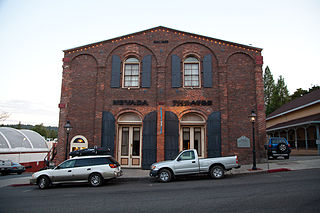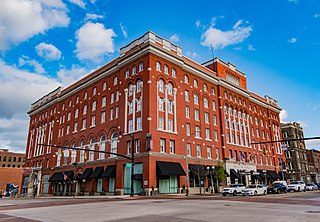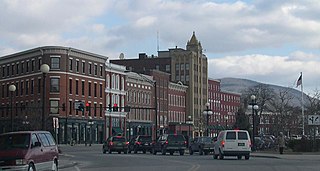
Cumberland is a city in and the county seat of Allegany County, Maryland, United States. At the 2020 census, the city had a population of 19,075. Located on the Potomac River, Cumberland is a regional business and commercial center for Western Maryland and the Potomac Highlands of West Virginia. It is the primary city of the Cumberland metropolitan area, which had 95,044 residents in 2020.

Frostburg is a city in Allegany County, Maryland. It is located at the head of the Georges Creek Valley, 8 miles (13 km) west of Cumberland. The town is one of the first cities on the "National Road", US 40, and the western terminus of the Western Maryland Scenic Railroad. It is part of the Cumberland metropolitan area.

The Alabama Theatre is a movie palace in Birmingham, Alabama. It was built in 1927 by Paramount's Publix Theatres chain as its flagship theater for the southeastern region of the United States. Seating 2,500 people at the time, it was the largest in the Birmingham theater district. The district was once home to many large theaters and movie palaces that featured vaudeville, performing arts, nickelodeons and Hollywood films. Built to show silent films, the Alabama still features its original Wurlitzer theater organ. The Alabama Theatre and Lyric Theatre are the district's only remaining theaters, and as of 2024, both are in operation.

The Woodstock Opera House is a historical venue for performing arts and receptions located in Woodstock, Illinois. It was built in 1889 and designed as a multi-use facility with space for city administration offices as well as police and fire departments. The building was planned by architect Smith Hoag and built by contractor Simon Brink for a cost of $25,000. Today, the City of Woodstock still owns the building, but the building is used exclusively as a performance space.

The Lyric Baltimore is a music venue in Baltimore, Maryland, United States, located close to the University of Baltimore law school. The building was modeled after the Concertgebouw concert hall in Amsterdam, and it was inaugurated on October 31, 1894, with a performance by the Boston Symphony Orchestra and Australian opera singer Nellie Melba as the featured soloist. Beginning in 1904, it was also used for touring performances by the Metropolitan Opera, and from 1950, it was the home of the Baltimore Opera Company until that company's liquidation in 2009.

The Grand Opera House is an opera house located at the corner of 8th and Iowa Streets in Dubuque, Iowa that was built in 1890. It was listed on the National Register of Historic Places in 2002.

The Maryland Theatre is a music and entertainment venue located in the Arts and Entertainment District of downtown Hagerstown, Maryland. It was built in 1915, partially destroyed by fire in 1974, reopened in 1978, and expanded into a full performing arts complex in 2019. The theatre's seating capacity is 1,279 people, and it hosts performances of symphony orchestras, country artists, comedians, children's shows, pop stars, recitals, stage shows, and others. Over 81,000 patrons attended performances at the Maryland Theatre in 2005, making it one of Maryland's premier venues for the performing arts. The Maryland Symphony Orchestra performs there regularly and has been headquartered in the building since 2019. The theater features a fully restored Wurlitzer theatre organ.

The Missouri Theatre, is a concert and entertainment venue in downtown Columbia, Missouri, occupying most of a city block between 9th street between Locust and Elm Streets. It was designed after the Opéra Garnier by the Boller Brothers, built in 1928, and is on the National Register of Historic Places. It is Columbia's only surviving pre-Depression movie palace and vaudeville stage. In 2011, the University of Missouri began a three-year lease of the facility. The Missouri Theatre is the resident home of the Missouri Symphony Orchestra, and is also frequently used by University of Missouri and civic groups. As of July 1, 2014, The University of Missouri took over ownership of the Missouri Theatre. It is one of the main performance venues for the University of Missouri School of Music.

The Grand 1894 Opera House in Galveston, Texas is currently operated as a not-for-profit performing arts theatre. The Romanesque Revival style Opera House is located at 2020 Post Office Street in Galveston's Historic Downtown Cultural Arts District. It was named "The Official Opera House of Texas" in 1993 by the 73rd Texas Legislature. It has a seating capacity of 1,040.

The Victoria Theatre is a historic 1,154-seat performing arts venue located in downtown Dayton, Ohio. The Victoria hosts a variety of events including theatre, music, dance, film, and comedy.

The Music Hall Center for the Performing Arts is a 1,731-seat theatre located in the city's theatre district at 350 Madison Street in Downtown Detroit, Michigan. It was built in 1928 as the Wilson Theatre, designated a Michigan State Historic Site in 1976, and was listed on the National Register of Historic Places in 1977.

The Grand Opera House, also known as The Grand or Masonic Hall and Grand Theater, is a 1,208-seat theater for the performing arts in Wilmington, Delaware, United States. The four-story building was built in 1871 by the Delaware Grand Lodge of Masons to serve as a Masonic Temple and auditorium. The construction cost was $100,000. It was designed in Second Empire style by Baltimore architect Thomas Dixon and incorporates symbolism from Freemasonry into the cast-iron facade. Its central pediment contains an Eye of Providence.

The Hippodrome Theatre is a theater in Baltimore, Maryland.

The Nevada Theatre, also known as the Cedar Theatre, located in downtown Nevada City, California, is California's oldest existing theater building. Its principal periods of significance were 1850–1874, 1875–1899, 1900–1924, and 1925–1949. It is situated on ancestral Nisenan land.

The Virginia Theatre is a live performance and movie theatre in downtown Champaign, Illinois. It has been providing theatrical and cinematic entertainment to the Champaign-Urbana community since its doors opened in 1921. Each year, the Virginia Theatre is host to movies from film reels, plays from various acting troupes, concerts, and Ebertfest, presented by the UIUC College of Media. It is currently owned by the Champaign Park District.

The Great Southern Hotel & Theatre is an historic hotel and theater building in Downtown Columbus, Ohio. The building currently operates as the Westin Great Southern Columbus and the Southern Theatre.

The Bama Theatre is a historic theatre in Tuscaloosa, Alabama that currently serves as the city's performing arts center. Its modern redevelopment is the result of cooperation between the Arts Council of Tuscaloosa and the Tuscaloosa County Parks and Recreation Authority. The three-story brick and limestone building is located at the corner of Gary Fitts Street and Greensboro Avenue in downtown Tuscaloosa. It was added to the National Register of Historic Places (NRHP) on August 30, 1984. It is also a contributing building in the Downtown Tuscaloosa Historic District, NRHP-listed in 1985.

Rutland Downtown Historic District, is the center of government for Rutland, Vermont. The sector of "downtown" is roughly defined as the area between Strongs Avenue, State, Wales, Washington, Pine, and Cottage Streets. The area is also a major center for business, and is considered the most cultural part of Rutland. Much of the area is also listed on the National Register of Historic Places as a historic district and includes 90 contributing properties. Some of these buildings date to the late 18th century, when Rutland was founded, but the greatest amount of expansion in downtown came after the marble industry became established on a large scale after 1850. The city's population tripled between 1850 and 1880, and many of the buildings built in this period were either built with or ornamented with marble.

The National Theater is a historic theater in Richmond, Virginia. Part of a section of Broad Street once known as Theatre Row, the National is the only one of the three original auditoriums still standing. Built in 1923, the theater was constructed with an adaptable stage that allowed it to show early motion pictures as well as live performances. It experienced a 1968 conversion to a dedicated cinema house and was renamed the TowneTheater, in which capacity it operated until closing in 1983. After an extensive renovation, the theater reopened in 2008 as The National, serving as a live music and performing arts venue.

The Providence Performing Arts Center (PPAC), formerly Loew's State Theatre and Palace Concert Theater, is a multi-use not-for-profit theater located at 220 Weybosset Street in downtown Providence, Rhode Island. It was built in 1928 as a movie palace by the Loews Theatres chain to designs by Rapp & Rapp, the leading designers of music palaces at the time. PPAC contains 3,100 seats and hosts touring Broadway shows, concerts, plays and films.






















